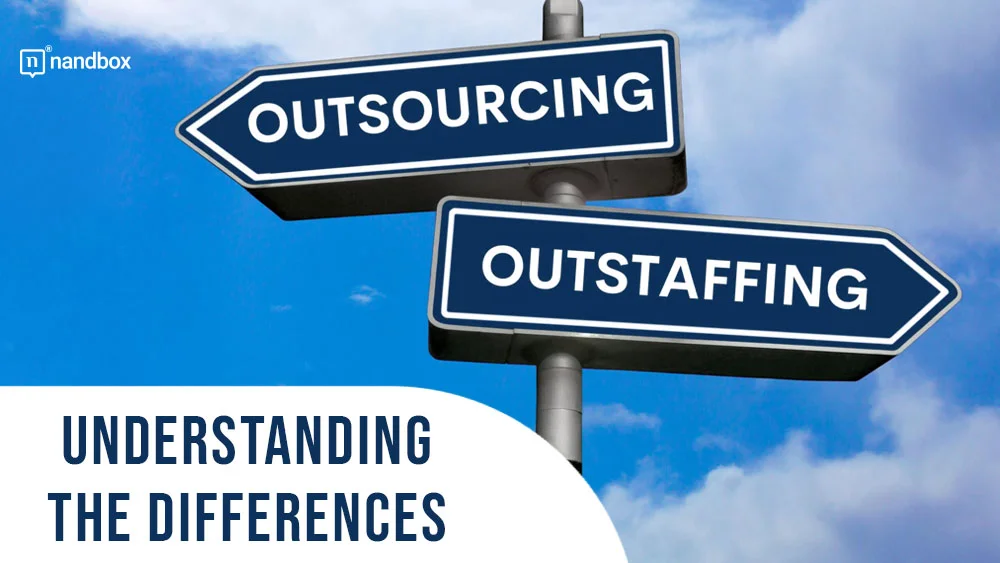People always find themselves in an exhausting dilemma where they need to make a choice between two things. To do this or to do that; to live here or to live there; to be or not to be. We all go through this situation. Whether it is as deep as choosing to exist or not or as simple as choosing red or white for your clothes. In this article, we will explore a major dilemma for businesses and organizations that aim to develop an app: choosing between outsourcing and outstaffing. Both strategies are now very popular among companies and businesses. However, which is better for your company and for building apps? Follow this article to learn more about outsourcing vs outstaffing!
What Is Outsourcing
Outsourcing is a hiring strategy that is only getting more popular with time. It is the strategy or process of hiring a third-party company with a specified specialization to manage one section of your company. Many major organizations rely on outsourcing in fields like human resources, marketing, and app development. For instance, if an e-commerce company needs to develop an app, instead of hiring app developers and creating a whole extension or section in the organization for development, they search for an eCommerce development company to assign them this part of operations. Another example is insurance agency outsourcing, where insurance firms might outsource claims processing or customer service functions to specialized third-party companies to enhance efficiency and focus on their core activities.
Outsourcing is an ideal option, especially since it is much more flexible than conducting a hiring process. And when it comes to mobile app development, outsourcing is the main option for many. There are many types of outsourcing, but the most common ones are offshore outsourcing and nearshore outsourcing. Offshore outsourcing is the process of assigning a part of your operation to a third-party provider in a foreign country. This type is favored by many organizations as it is less costly and allows them to expand their horizons to different regions and countries. For example, Workday is a cloud-based human capital management (HCM) and financial management (ERP) software system used by many large businesses across the globe. Most of these companies outsource Workday consulting from a foreign/local third-party provider to help their organizations implement, configure, and use this software to improve their business processes.
On the other hand, nearby outsourcing is the process of assigning a part of your operation to a third-party provider in a somewhat nearby place, whether a nearby county, state, or town. As long as it is not in the same place that your company is based.
A good example is how some U.S. companies go for nearshore outsourcing in Argentina when they want to keep communication smooth and time zones aligned, without giving up on quality or affordability. It’s a practical option for teams that want easier collaboration while still cutting costs.
Pros of Outsourcing
Cost and Time Efficient
Among the many benefits of outsourcing, what makes it very special and a common strategy for many businesses is that it is cost- and time-efficient. Outsourcing, especially offshore, saves companies tons of money that they’d spend if they decided to create a whole extension of the business or hire people. Additionally, it shortens the time taken by a fraction. Instead of this hassle, outsourcing gives them many options with different costs that they are free to choose from.
Focus on Key Objectives
Usually, when a company turns to outsourcing, it is because they need someone to handle an operation or a project that is outside their field of expertise. So, rather than focusing on finding ways to handle these types of operations, which of course call for conducting much research, recruiting, and managing them, companies find individuals or organizations with the required specialization to handle everything from A to Z. This way, companies can focus on more important aspects and objectives.
Scalability and Flexibility
What makes outsourcing special is that it provides companies with great flexibility and scalability. Companies can easily customize the outsourced teams according to their unique needs and preferences. According to the project or operation they need to accomplish, they can choose to scale up or down the outsourced team.
Access to a Wide Talent Pool
Lastly, outsourcing allows companies to have access to different talents, specializations, and skills. Whether individuals or companies, they can choose from many and varied areas of expertise. This is certainly based on what the project or operation calls for. For instance, if you want to develop a simple app, you wouldn’t choose an individual or company with 10+ years of expertise. Instead, you’d have other choices with a suitable set of skills and experience.
Cons of Outsourcing
Communication and Language Barriers
As much as offshore outsourcing or outsourcing as a whole can be beneficial, it can also have many issues. One of the major issues facing such a strategy is communication and language barriers. You’d find a great outsourcing company in another country with all the requirements that you need. However, communication would be a tad difficult or completely absent due to the fact that both entities are literally miles away from each other. Also, language can be another major barrier that worsens communication.
Potential Security Risks
When hiring an outsourcing company, you need to keep in mind that there is a slight chance of security risks. Hiring an outsourcing company means sharing sensitive information about your organization and having access to the whole system. However, no matter how great the outsourced company is, there is always a slight chance of a data breach or leakage.
What Is Outstaffing

Done with outsourcing, let us not switch to outstaffing. Outstaffing is another popular strategy implemented by many companies and businesses, especially in app and software development. It is the process of hiring someone who works for another company to accomplish a certain task. The company would already have current employees for this certain operation, but the out-staffed employee is just an additional resource. Just like outsourcing, companies can out staff people from all around the world, who would work remotely for them. When exploring outstaffing models for international operations, businesses often turn to Employer of Record (EOR) services to simplify legal and administrative processes. For example, a UK EOR can handle compliance, payroll, and employment requirements, allowing companies to focus on managing their teams effectively without establishing a local entity.
Pros of outstaffing
Reduced Administrative Burden
One of the top benefits of outstaffing in this Outsourcing vs Outstaffing comparison is reducing administrative burden. You can avoid the hassle of handling payroll, benefits, and other HR-related chores by outstaffing work to remote workers. In addition to lowering the chance of compliance problems, this can save your company both money and time. Additionally, outstaffing providers often handle the recruitment and onboarding processes, further reducing the administrative burden on your company. A popular method for outstaffing involves using an Employer of Record (EOR), which can manage the intricacies of international hiring. This approach not only streamlines the process but also mitigates the risk of non-compliance with labor laws.
Time and Cost Saving
Saving money and time is a major benefit of using outstaffing. Companies can save money on HR expenses, including hiring, training, and managing remote workers, by using a third-party provider. In addition, by using an outstaffing service, companies can quickly increase or decrease their workforce as needed without suffering the high costs and long delays associated with recruiting and laying off workers.
Improved Efficiency and Productivity
Your organization may see increased production and efficiency as a result of outstaffing. Your team will be better able to focus on core business processes if you out-staff some jobs or projects to remote workers. Increased productivity, better results, and great efficiency could result from this. In addition, when you outstaff, you have access to a larger pool of potential employees, including experts in fields that may be uncommon in your area. Your business’s ability to innovate and compete in the market will benefit from this. Additionally, specialized tools tailored for specific industries elevate efficiency even further. For plumbing professionals looking to streamline their work processes, adopting a plumbing app for professionals can make estimating and invoicing more accurate and considerably faster. This not only saves time but also enhances customer satisfaction by speeding up service delivery.
Cons of Outstaffing
Potential Communication Delays
The potential for communication delays is a major drawback of using outstaffing. It can be challenging to effectively communicate and collaborate with remote employees due to factors like time zone differences, language obstacles, and technical difficulties. Both the business and team members may become frustrated as a result of missed deadlines and reduced output. Establishing clear communication protocols and selecting a provider with a history of efficient communication are both crucial. However, having an employee communication app for your business can help reduce this.
Another drawback of outstaffing is the possibility of arrangements becoming unstable. Disruptions to the working relationship might occur if the outstaffing provider experiences financial difficulties, legal concerns, or a change of ownership. There’s also the risk that an employee who is inadequate will suddenly quit, leaving the company without a vital employee. Choose a provider with a solid history of success and have backup plans ready in case something goes wrong.
Limited Control
The last major drawback of outstaffing is the lack of supervision over remote employees. While businesses can still provide some structure and direction for remote workers, they may not have as much control over them as they would with full-time employees. Troubles in communication, failure to meet deadlines, and other problems might arise as a result. To reduce the likelihood of these negative outcomes, it is crucial to set up transparent channels of communication and definite goals right away.
Outsourcing vs. Outstaffing: Which Is Better for Your App
Outsourcing and outstaffing are both very important and beneficial strategies for any company looking to develop an app, without spending tons of cash. Alongside the listed pros and cons of both outsourcing vs outstaffing, there are many more that you will experience during your journey. However, this doesn’t make any of the strategies less important or ineffective than the others. Choosing either of them is solely based on your requirements and needs. For example, if you already have an established development department but think about having someone with a different perspective, outstaffing is for you. After all, the more, the merrier.
On the other hand, if you don’t have this department established and don’t have enough resources for hiring and adding a new team for your company, then outsourcing is your best choice.
Choosing either strategy also depends on other factors like budget, communication, and any others that you need to prioritize before settling on one.
Keep in mind that you can also disregard both with the rise of new app development techniques that make the process a one-man mission as easy as pie. These techniques are low-code and no-code, which are now the top choices for many businesses. No-code and low-code offer the same pros of outsourcing and outstaffing with fewer cons. Platforms like the nandbox app builder allow businesses to develop fully-functional apps in no time. You can learn more about nandbox’s astonishing capabilities here! And who knows? Perhaps this is where you’ll finally find success in business.




